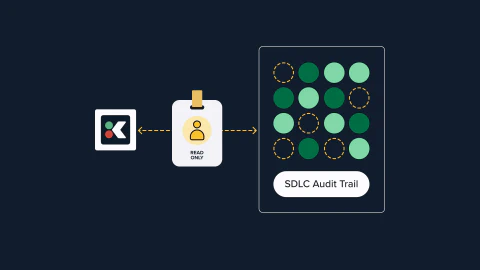Many DevOps teams work proactively to meet security and compliance standards. They consider security best practices when developing software with open source components, scanning code for vulnerabilities, deploying changes, and maintaining applications and infrastructure. Security is a key feature of many of the tools they’re using, and the policies and industry standards they’re following.
But, while security concerns continue to be top of mind for the software industry, the importance of continuous security monitoring over what’s actually running in production environments is often overlooked. In the current climate this is essential to keep your business (and your customers) fully protected from cyber threats.
There’s currently a big focus on supply chain, SBOMS, and so called “golden paths,” to production. While these are a good start, and will enhance your security, even when executed perfectly they can’t guarantee that the software running in production is compliant and secure.
That’s where continuous security monitoring software that tells you what’s actually running in production comes into play.
What is Continuous Security Monitoring Software?
Kosli’s continuous monitoring software monitors runtime environments for changes and whenever it detects a change it takes a snapshot of the environment and stores it in an append-only journal of record. That historical record enables quick comparisons between what’s running now and what was running 1, 2, or 100+ snapshots ago. And you can easily diff those snapshots to quickly understand what has changed when an unauthorized change is made, or an incident occurs.
You can configure Kosli to alert you anytime something starts running in production that shouldn’t be there - either a malicious deployment from an external user, or an unauthorized or non-compliant deployment from inside your org.
Our continuous auditing features— including our Evidence Vault— can help you track what changes were made, whether or not they were compliant, and who was involved.
You can see how it works here:
Why Does Security Monitoring Software Matter?
Cyber security threats are always evolving. New threats emerge regularly, meaning that security best standards (and, in many cases, regulations) are always frequently evolving, too.
In many cases, cybersecurity threats originate from within the infrastructure that businesses create, and the processes they follow. This means that your DevOps team needs to be developing, testing, and implementing code that’s following all best practices to reinforce any weak links in the chain.
In addition to training your team to follow certain security standards with code review and compliance monitoring, it’s also important to implement ongoing security monitoring to ensure that your software and code is being implemented as intended.
Internal mistakes, even with steps taken to enforce compliance, can result in weak spots in your system. Even with the best compliance efforts, sometimes there is a threat of someone either internally or externally sidestepping those measures to deploy code with vulnerabilities. Checking the boxes on a security checklist to “ensure compliance” isn’t enough to guarantee security.
Since so many businesses have multiple teams with new changes being deployed daily, there’s much room for potential disaster (accidental or otherwise). Not only could you find yourself out of compliance with security standards, you open the door to potential cyber threats that could cause data theft, tampering, or destruction.
Ongoing security monitoring software can help you flag any potential liabilities so you can address them quickly and determine where they came from.
Since new regulations in both the US and the EU are putting increasing demand on software teams, continuous security monitoring software can help you to prepare for and adapt to changing regulations regarding data security and compliance.
The Advantages of Real-time Detection and Response
Some companies rely on compliance audits or occasional security monitoring, believing that compliance-focused policies will be enough to catch any potential issues. This approach, however, opens you up to significant vulnerabilities.
If there’s a potential weakness in your system, whether it’s an actual vulnerability or a failure to adhere to compliance regulations, you don’t want to wait six weeks to have it pop up on an audit. You want to know right away, especially since you could run a review and have malicious or non-compliant code uploaded an hour later.
This is why it’s important to use security monitoring software that’s truly continuous, not once a week, or once a month, but continuous.
You need to be able to identify security issues immediately with real-time alerts so breaches and incidents can be resolved promptly, before any kind of damage is done. Worst case scenario, you can at least significantly mitigate any damage that does occur by responding quickly.
DevOps teams in highly-regulated industries are often slowed down when their organization has to achieve compliance with new industry standards. In this case, getting real-time alerts informing you of what’s no longer compliant is invaluable, enabling you to move quickly without taking risks.
Cybersecurity Challenges
When considering cybersecurity, it’s important to address the cybersecurity and general security challenges that many businesses face. These are the six most significant concerns that are currently impacting businesses today.
Knowing The Types of Common Cyber Attacks
Cybersecurity attacks are constantly changing. As soon as organizations strengthen their defenses against one kind of attack, attackers shift and find a new option to exploit.
Right now, the most common types of cyber attacks are:
- Malware, which can include any program or code created to do harm
- Denial-of-Service attacks
- Spoofing
- Identity-based attacks
- Code-injection attacks
If malware is changing or impacting your code, you’ll see what’s been changed and when. If a spoofing or identity-based attack has allowed someone to break in and alter your code, you’ll be able to see when the changes were made and who made them so you can get to the bottom of it. And any code-injection attacks will be easy to trace, as you’ll receive real-time alerts if any code isn’t compliant.
Remote Work Increases The Risk
Remote work is more popular than ever before. While there are plenty of benefits to remote work, there can also be security concerns.
Remote access presents new challenges, increasing the risk of data breaches and identity theft. And with teams not back in the office, they’re potentially distributed across the country or even the world. This can make collaboration difficult.
What did people on the other side of the globe change while the other team members were asleep? What’s even been changed, and was it an approved change? You need to understand all changes happening and whether or not they’re both secure and compliant.
Tight Budgets
Proactive cybersecurity and monitoring efforts may be expensive for some businesses, and when many brands have a long list of costs to balance, sometimes this is what gets cut.
This is a gamble. Some small businesses in non-regulated industries may be willing to take that gamble, but those in highly-regulated and heavily-monitored industries like healthcare, legal, and fintech, this is not a risk you want to take.
CISOs are familiar with this, as they’re often being asked to do more with less. There are more attacks, a smaller budget, and fewer team members to work with, and everything concerning security tasks is mission-critical. This is so stressful that CISO leaders are resigning in droves.
You want to be in a proactive instead of reactive position, as waiting until the damage has been done can be wildly expensive due to data loss or damage, damage to your business’s reputation, and potential fines. Breaches in the healthcare industry alone may cost an average of $10.1 million, but that’s nothing compared to the brand and reputational damage.
Severe and even repairable damage is on the table. If you’re providing software for cars or heart monitors, for example, a single breach could become catastrophic if the data breach literally kills a customer.
Lack of Updated Cybersecurity Knowledge
Many DevOps team members can be highly skilled when it comes to building, testing, and implementing great code that works well— but not every great software developer is also up-to-date on the latest trends and regulations in cyber security, especially since changes can happen so quickly.
As a result, they may need to rely on third-party service providers or tools, but they may not know they even need it. In some cases, businesses don’t realize they need the help until after a security breach has already occurred, especially when they thought they were covered by their compliance certifications.
Compliance certifications alone— and even a few security-focused tools— won’t protect you. Box checking a list of regulations doesn’t protect you just because the paperwork says you’re good. So many compliance approaches are based on team members declaring they’re doing the right thing, but using a tool like Kosli to ensure that’s actually true for the code running in the production environment is invaluable.
Choosing the Right Continuous Security Monitoring Tool
If you’re researching continuous security monitoring tools, it’s important to know where to start.
Keep in mind that there’s no “one tool to rule them all,” because so many tools offer different features. The trick comes down to finding the right tools for the right tasks.
Kosli, for example, offers monitoring to help you assess runtime and environment changes to help you determine what code is actually running - and where it came from. We’ll help you connect how changes happen across your tools, which can help you make sense of what’s happening in the logs and dashboards across the rest of your stack.
Here’s what you should look for:
- Focus on security compliance and security monitoring. Most tools offer one or the other; they’ll either help your team ensure that they’re following your business’s or industry-required security practices or they work in vulnerability detection, but not both.
Make sure that you’re choosings tools that offer both so that you’re fully protected, because compliance is an important foundation, but you need ongoing security monitoring in case something slips through (which it often does at scale). - Budget compatibility. Any tool that you choose should align with your existing budget. Remember, though, to consider the costs of a potential cybersecurity threat, or the costs associated with a failed audit when determining how much you’re willing to spend.
- Scalability options. A large DevOps team needs a security monitoring tool that can work at their scale. Some tools have strong limitations here, so choosing software that’s compatible with the choices made by your DevOps team will be a huge advantage.
- Integrations with your existing tech stack. It’s important to choose a tool that will work with your existing workflow. Consider what integrations are available with both your security and DevOps tech stacks and infrastructure to minimize disruption.
Best Practices for Implementing Continuous Security Monitoring
If you’re ready to get started with continuous security monitoring, remember to implement the following best practices.
1. Identify What Data You Want to Protect
Identifying the data that you need to protect is an essential place to start. What systems need to be kept up-to-date, and which need to be monitored?
From a cybersecurity standpoint, for example, you may have a credit card database protected, but you haven’t followed industry standards for the customer database or your lead generation platform that accepts new customer information— that’s a risk and a problem.
Don’t forget that coding isn’t just about your website and the software your team is developing; your entire Cloud-based tech stack and mobile app development must be considered, too.
2. Ensure Your Security Software Updates Regularly
Just as security regulations update regularly alongside new threats in cybersecurity, you also want to make sure that the software you’re using for security monitoring is updated regularly, too.
Choosing the right tool will help with this. You specifically want to look for software that updates not only new features regularly, but that’s staying on top of all regulations that could impact your business, including industry-specific ones.
When meeting with the sales department, make sure you ask about this. A good hint that they’re regularly updating their software, however, is a published changelog on their site.
3. Create Documented Security Monitoring Processes
Documentation is critical when it comes to security enforcement and compliance for DevOps teams. It allows you to communicate what’s expected, which business processes to follow, and how to maintain security compliance.
Train your team with the documented security processes, and make sure they understand how to use your chosen tech stack. Ideally, your team will use security compliance software to enforce these policies throughout the entire production process.
Keep in mind that deviations in standard user behavior can be a significant red flag, so ensuring that everyone using the same processes will not only keep you compliant, but it will help you to flag potential issues more effectively.
4. Prioritize a Smooth Roll Out
When rolling out new cyber security monitoring software of any kind, remember that a smooth roll out goes a long way.
Following these steps can help:
- Prep your team on any new policies that are being put in place
- Explain how the new software works, and what it will do
- Have the documentation from the previous section ready to go, and train your team
- Choose an “off time” to implement the new software in case there are any issues with set up, training, or integrations that causes hiccups in your process
- Ensure that employees have regular ongoing training, especially if there are ever updates or new features to the tool itself
Final Thoughts
Continuous security monitoring is essential for all businesses, but especially those in highly-regulated and rapidly-changing industries— even if you already have a big focus on compliance.
Taking proactive steps will help you to secure your systems both short-term and long-term, and to keep your systems compliant. This can be an enormous cost-saver, and it can prevent significant issues and expenses down the line.
Interested in learning more about continuous security monitoring software? See how Kosli can help you build stronger security (and security compliance) at every stage of DevOps production.
















